The current season has been nothing short of a nightmare for Fluminense.
The team’s worst start since 2006, with just six points after twelve games, leaving fans and analysts alike scratching their heads.
Despite a talented roster and a coaching staff with a proven track record, Fluminense is struggling to secure victories and is slipping down the league standings.
In this Fluminense scout report, we conduct an in-depth analysis of the myriad issues plaguing the team.
From tactical missteps and ineffective tactics to injuries and off-field distractions, this Fluminense tactical analysis and scout report aims to uncover the root causes behind Fluminense’s disappointing campaign so far.
Fluminense Managerial Insights
The season began with Fernando Diniz, a coach known for his reliable track record.
Diniz rejoined Fluminense in 2022, leading the team to victories in the Copa Libertadores last season and the Recopa Sudamericana in February.
Despite these previous successes, Fluminense managed to secure only six points from 11 games this season.
The final blow was a 1-0 loss to Flamengo, which ultimately led to his dismissal.
So, where did the club’s issues with the manager begin?
The problems arose from both managerial decisions and the actions of the club’s higher executives.
Fluminense’s president, Mario Bittencourt, emphasized that Diniz’s dismissal was not due to a single poor result but rather an overall assessment of the team’s recent performances and internal dynamics.
A coach must adapt the team’s playing style during tough times, making micro adjustments rather than overhauling the entire starting lineup or coaching philosophy.
These minor changes accommodate the specific issues the team faces on the pitch.
Due to injuries and the old age of key veteran players, Diniz had limited options for making such adjustments.
From the start of the season until his sacking, he did not have the chance to field the same starting 11 more than once, which was purely a matter of bad luck.
Diniz’s playstyle and philosophy had become outdated and ineffective for the current players, and the tactics could no longer produce results.
Fernando Diniz liked to play with Relationism, a philosophy he has successfully implemented at several clubs, including Fluminense.
His teams are known for their fluid attacking play, unpredictable movements, and emphasis on creating overloads.
Relationism relies on players having freedom and using their IQ to scan the next movement to make and where to be in order to anticipate what will happen next.
They use non-verbal communication, body language, and subtle cues to create passing triangles, overloads, and attacking opportunities.
This style aims to create space by constantly moving and occupying different positions, generate attacking opportunities by focusing on overloads and exploiting space, and disrupt the opposition with its unpredictability, making it difficult for opponents to defend.
At Fluminense, Diniz’s Relationism is evident in their fluid attacking play and constant player movement.
Fernando Diniz’s style of play includes build-up by creating overloads in widths of the pitch, and a heavy tilt to progress up the field; players frequently change their stance on areas of the pitch to create space and attacking opportunities.
This makes it extremely difficult for a team to know what is going to happen next and how to defend or attack in transition.
A prime example of a team that excels at this method of football is Real Madrid, who execute it exceptionally well.
Their ability to seamlessly transition between defence and attack while maintaining unpredictability showcases the effectiveness of this approach when implemented correctly.
Unfortunately, Fluminense’s current struggles highlight the challenges of replicating this style without the right balance of player capabilities, player profiles, and tactical coherence.
Positives
Relationism is characterized by adaptability.
It allows players to react to any situation, making them unpredictable and challenging for opponents.
This philosophy empowers players, giving them more freedom and responsibility on the field, leading to a dynamic and engaging style of play.
The tactical idea is to overload certain widths of the pitch and look for transitions.
Evidence of this can be seen below.
The players marked in black are creating the overload, and the goal is to quickly transition the ball to those marked in yellow.
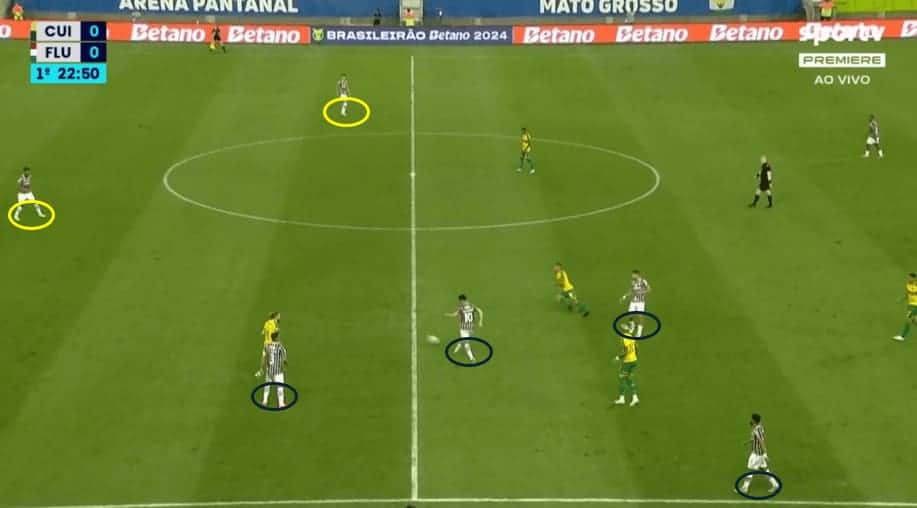
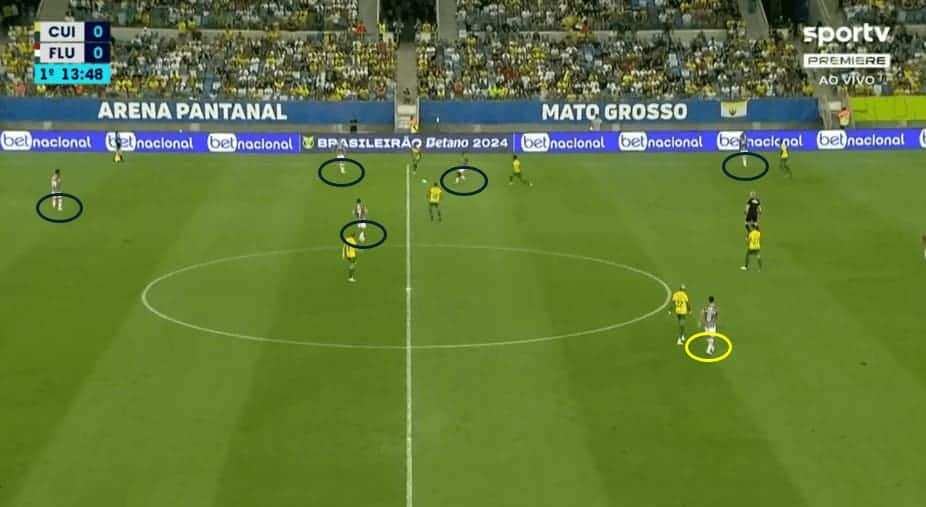
Negatives
Relationism is demanding as it requires skilled, tactically aware, and communicative players.
Its attacking focus can leave teams vulnerable if they lose possession, exposing them to counterattacks.
Mastering this philosophy involves a significant learning curve, requiring extensive training and understanding from the players.
This has contributed to Fluminense’s struggles, as young players may not have fully adapted to this style, while veteran players might struggle to execute it effectively due to age.
Below, we can see instances of vulnerable counter-attacks that highlight these issues.
In the first image, we see a 2v2 scenario with no Fluminense wingbacks present to provide support.
The Fluminense defenders are marked in black, and the attackers are marked in red.
It’s clear that this situation is about to escalate into a 4v2 scenario as the other two attackers, who are outpacing the Fluminense midfielder, join the play.
This highlights the vulnerability of Diniz’s Relationism when possession is lost, leaving the team exposed to rapid counter-attacks.
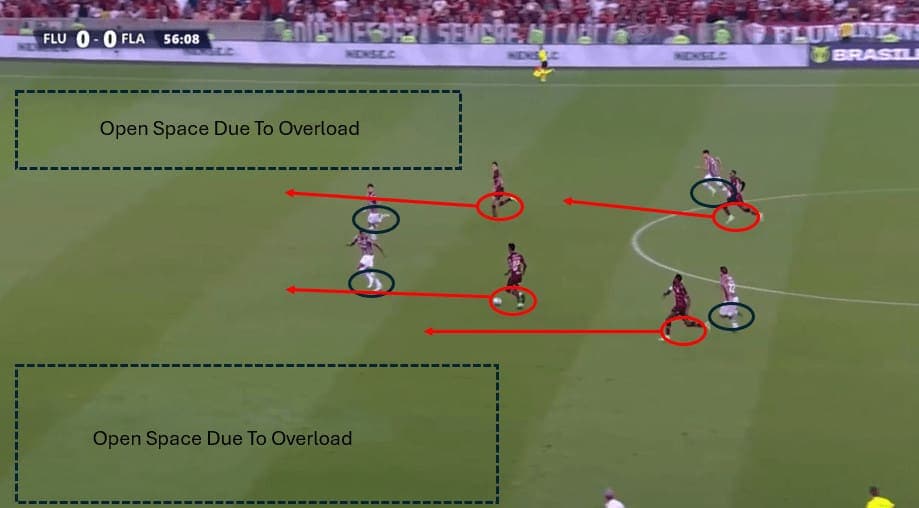
In the second image, we again see a vulnerable scenario with no Fluminense fullbacks able to support since they are up the pitch trying to play an overload tactic.
This leaves a 2v2 situation, which is soon to become a 3v2 or 3v3 scenario with the attackers marked in red.
This further illustrates the risk associated with Diniz’s Relationism, where the attacking focus can leave the team exposed to counter-attacks when possession is lost.
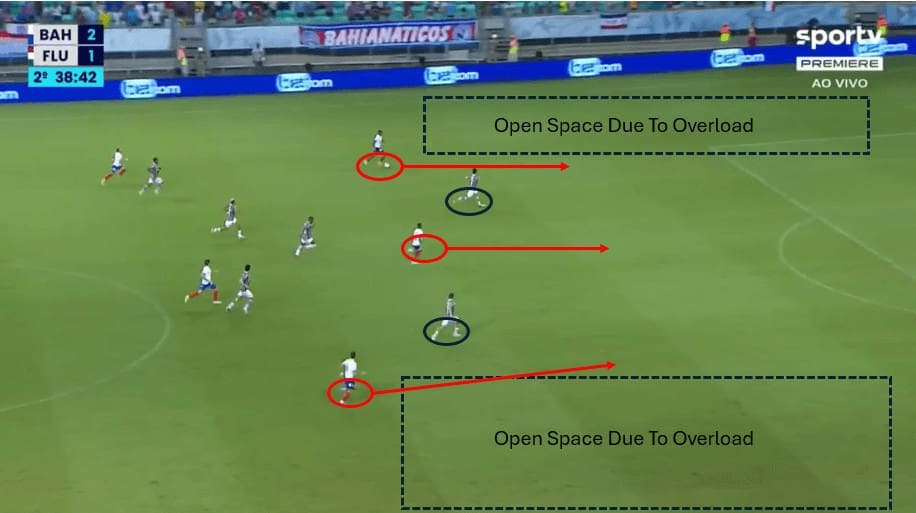
What Went Wrong
Given its demanding playing style, Relationism requires players who can fully understand and execute the coach’s instructions.
Think of a classroom where the coach is the teacher, guiding students to build a cardboard car.
The teacher can provide all the materials and knowledge needed, but if only half the students understand while the other half do not, the classroom will struggle to complete the project.
Students may be left holding glue, cardboard, and paint, unsure of what to do next.
Similarly, Fluminense faces difficulties with players who either have yet to grasp this complex system or, due to age, can no longer perform as required, leading to inconsistent execution on the pitch.
Fluminense faces a similar issue with the composition of their squad.
The current squad’s average age is 28, but this number is skewed by key players who are between 34 and 41 and younger players who are between 19 and 21.
This creates a significant gap, as veteran players may no longer have the physical capacity to perform as they did in their prime, and the younger players lack the experience to implement the coach’s complex plans fully.
The absence of players in the prime age range of 24-29 exacerbates the problem.
Relying on very old players like Marcelo, Thiago Silva, and Felipe Melo to perform as if they are still in their prime is unrealistic, while young talents like Marquinhos and Martinelli are still learning and adapting to the competitive level and playing style.
This imbalance hinders the team’s ability to execute the demanding tactics effectively.
Fluminense Key veterans
Fluminense Goalkeeper – Fabio
The radar chart for Fábio, a 43-year-old goalkeeper for Fluminense, highlights various aspects of his goalkeeping performance over 630 minutes played this season.
Fábio’s strengths lie in his interceptions, with an impressive percentile rank of 85.7%, indicating his adeptness at reading the game and breaking up opposition plays.
However, his metrics for clean sheets and shots against per 90 are relatively low, pointing to challenges in maintaining a solid defensive line.
His expected goals against (XG Against) per 90 and conceded goals per 90 are concerning, reflecting the high number of quality chances faced by Fluminense.
Additionally, Fábio’s save rate is 57.1%, suggesting that while he can make crucial saves, there is significant room for improvement.
His performance in aerial duels and exits per 90 is average, showing a balanced but not outstanding command of his penalty area.
Overall, the chart plus external information can suggest to us that they should look to find a new goalkeeper.
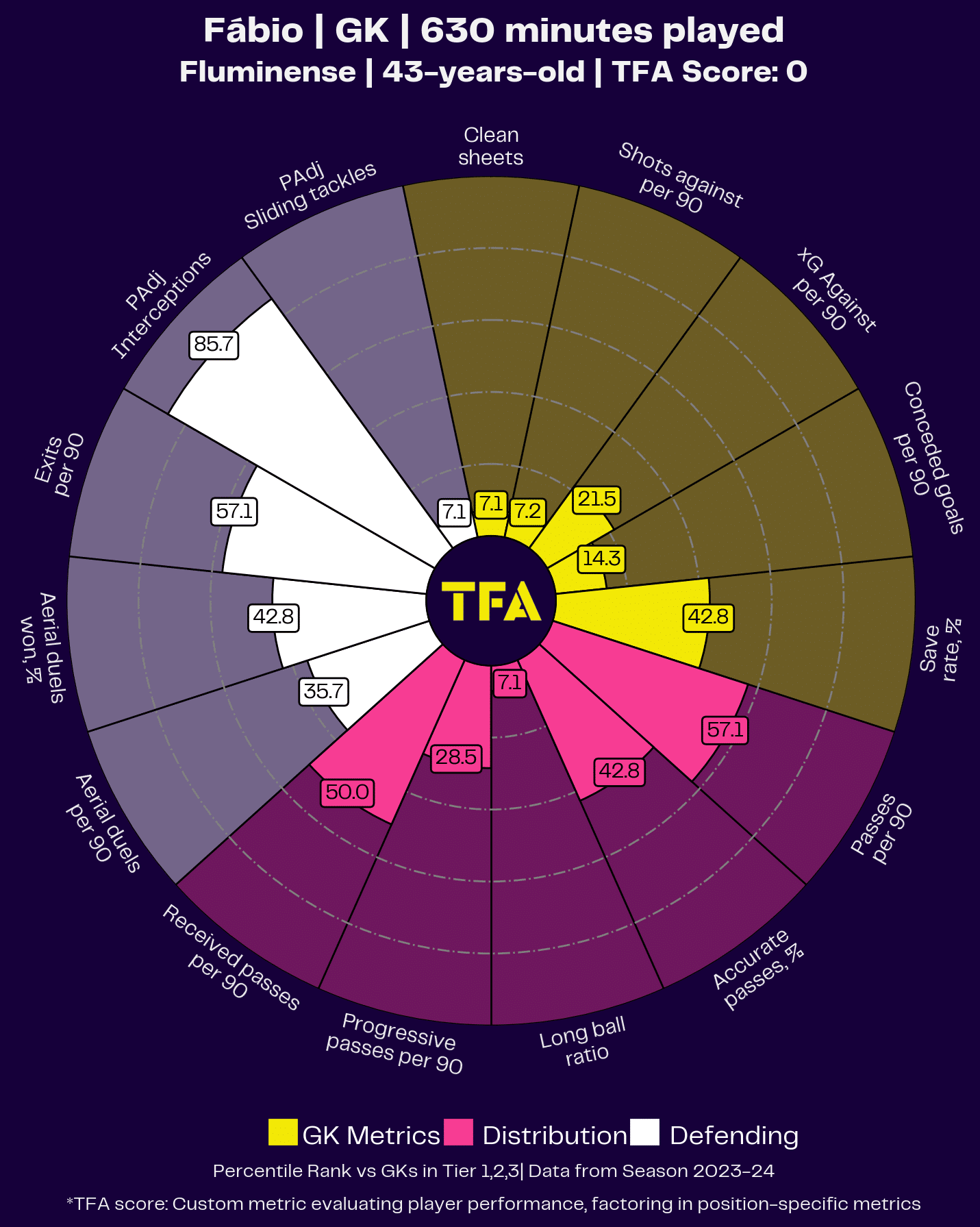
Below is the graphic for the shots faced by the keeper.
Facing 26.2 expected goals (XG) over only 17 matches is alarming, highlighting significant defensive issues.
While this is largely a reflection on the defence, the goalkeeper’s performance is also underwhelming, with only 4.2 goals prevented.
This suggests that despite the high volume of quality chances faced, the keeper has not been able to make the crucial saves needed to mitigate the defensive shortcomings, further compounding Fluminense’s struggles.
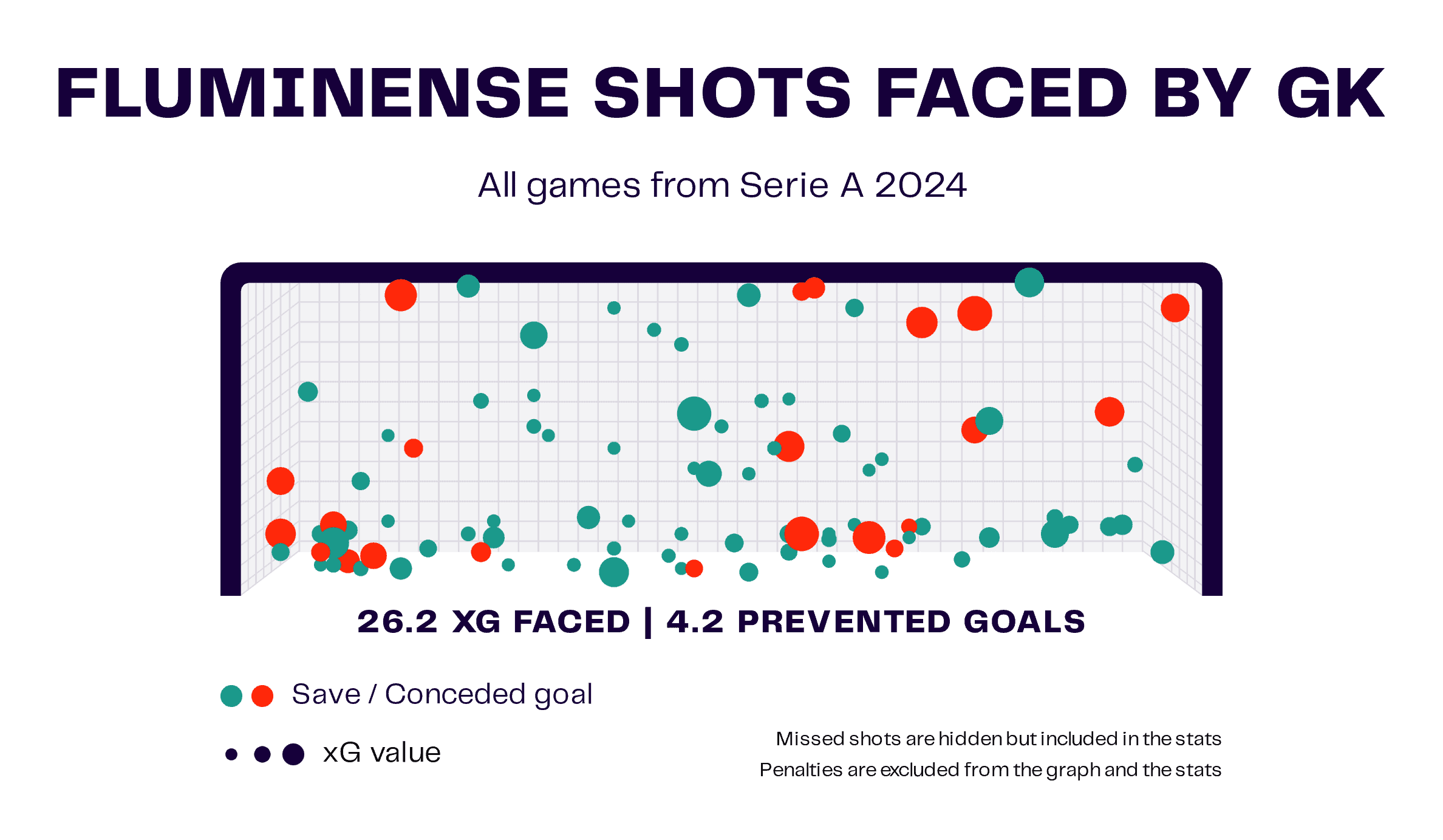
Fluminense Defenders – Felipe Melo and Marcelo
The radar chart for Felipe Melo, a 39-year-old left centre-back for Fluminense, illustrates his defensive performance over 866 minutes played this season.
Melo’s defensive prowess is highlighted by his strong positioning, with a percentile rank of 74.25%, indicating his ability to maintain effective defensive alignment.
His aerial duel success is solid, winning 42.7% of his duels, though there’s room for improvement.
Melo ranks in the lower percentile in terms of defensive duels per 90, suggesting that while he engages in a fair number of duels, his success rate is modest.
Felipe Melo’s defensive contributions extend to his role in intercepting and breaking up play, as evidenced by his defensive duel metrics.
However, his performance in defensive duels per 90 is lower than average, highlighting a potential area for enhancement.
Despite these challenges, Melo’s experience and tactical awareness are crucial for Fluminense’s defensive strategy.
However, looking at the player’s overall package, he no longer ranks highly in any percentiles and has lost some of his class due to age.
This is a major problem, especially as he is the captain and main centre-back of the club.
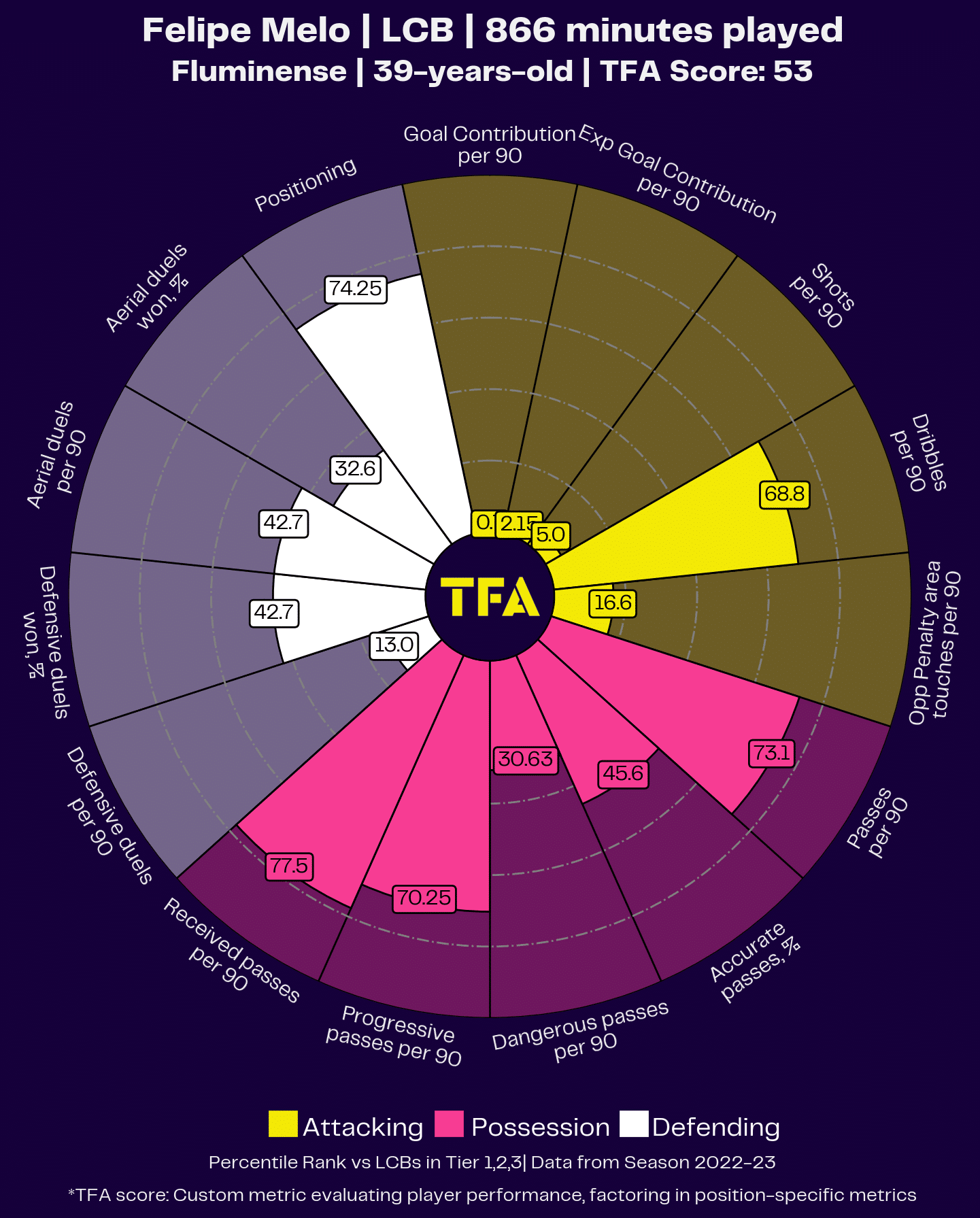
The radar chart for Marcelo, a 34-year-old right centre-back for Fluminense, highlights his performance over 2482 minutes this season, focusing on defensive attributes.
Marcelo excels in aerial duels, winning 72.1%, showcasing his strength in handling high balls.
His positioning, with a percentile rank of 61.55%, reflects his tactical awareness and ability to maintain defensive structure.
In defensive duels per 90, he ranks at 40.8%, with a success rate of 61.6%, indicating frequent engagement but with room for improvement in effectiveness.
However, Marcelo, another key veteran player, does not rank highly anymore in any categories and has lost some of his touch due to age.
He has become a left-back liability, struggling with overlapping and returning for defensive duties.
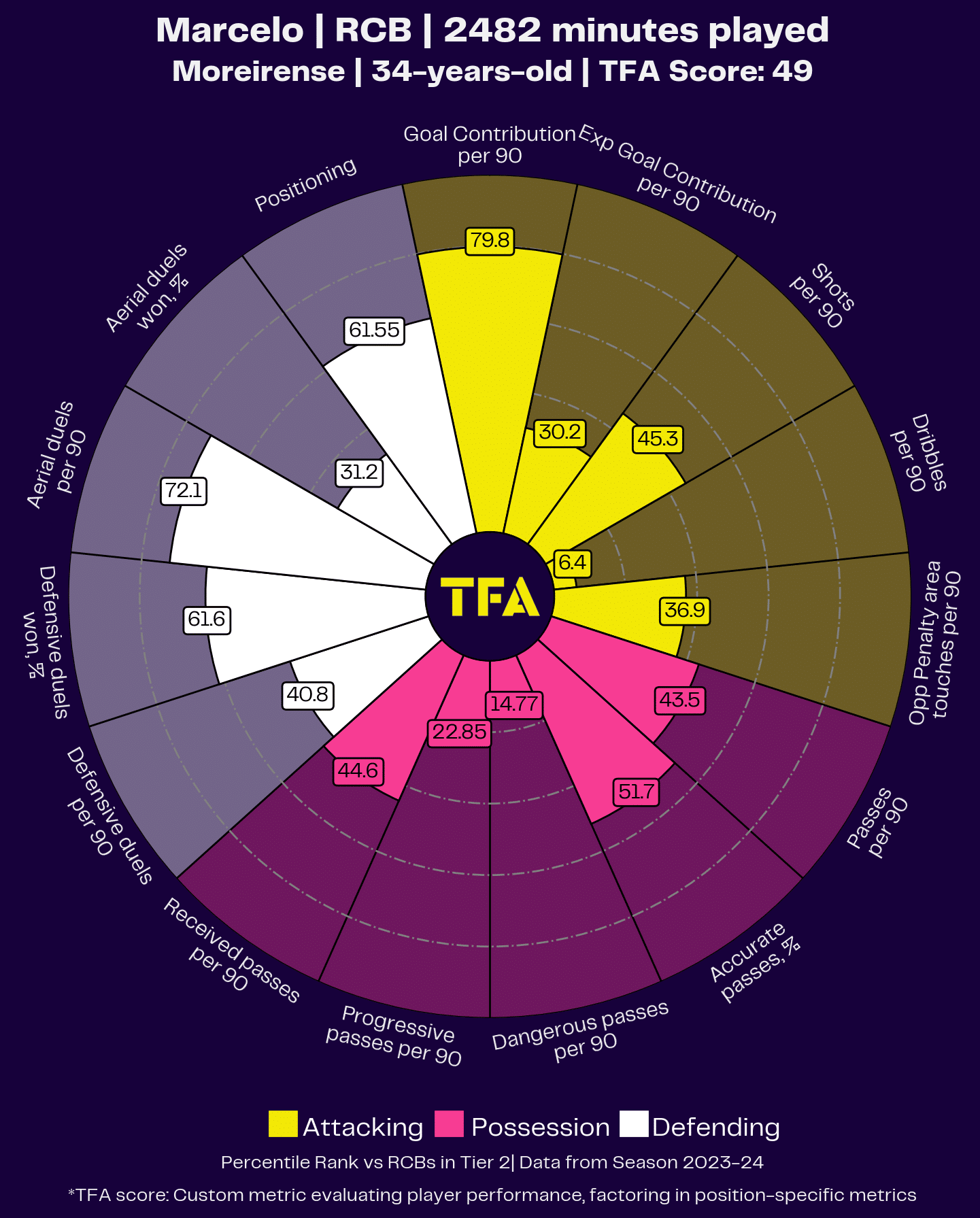
The graphic below illustrating Fluminense’s defensive territory in Serie A 2024 reveals critical insights into their defensive actions, interceptions, and fouls.
The majority of defensive actions and interceptions occur in the middle third and defensive third of the pitch, indicating a focus on regaining possession and disrupting plays in these areas.
However, the significant number of fouls, marked in red, highlights potential issues with discipline and timing in defensive challenges.
This pattern suggests that while Fluminense is active defensively, opponents can exploit its vulnerabilities, particularly in transition phases.
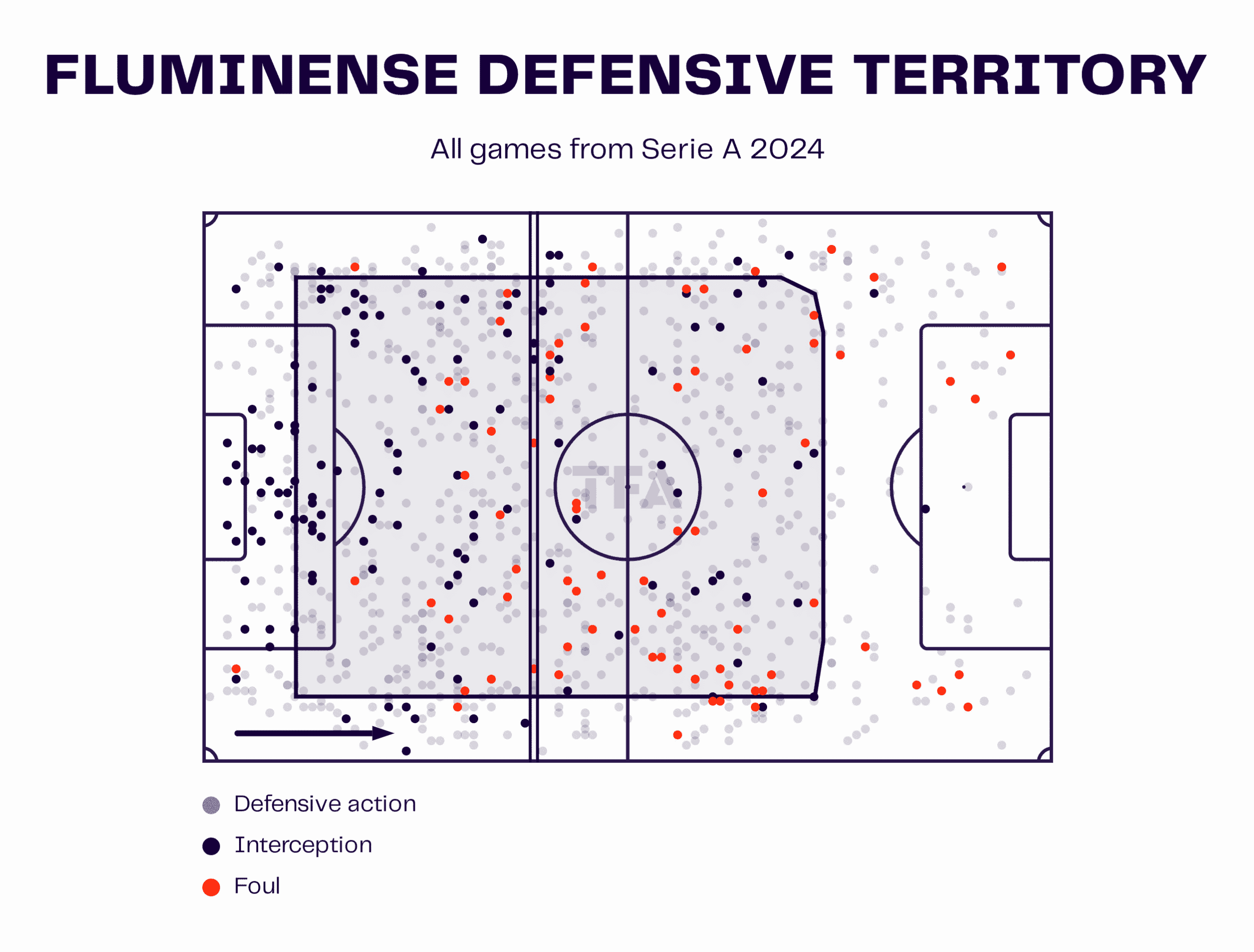
Fluminense Attackers – German Cano
The radar chart for Germán Cano, a 36-year-old centre forward for Fluminense, showcases his performance over 452 minutes played this season, with a primary focus on his attacking metrics.
Cano’s goal contribution per 90 and expected goal contribution per 90 both stand at 40%, indicating his potential to impact the scoreline, though there is room for growth.
His performance in shots per 90 (50%) and dribbles per 90 (30%) suggests a moderate level of offensive activity.
Cano’s touches in the opponent’s penalty area per 90 are also at 30%, reflecting his ability to position himself in dangerous areas.
However, his progressive passes per 90 and dangerous passes per 90 are notably low, both at 10%, highlighting a need for improvement in creating and contributing to attacking plays.
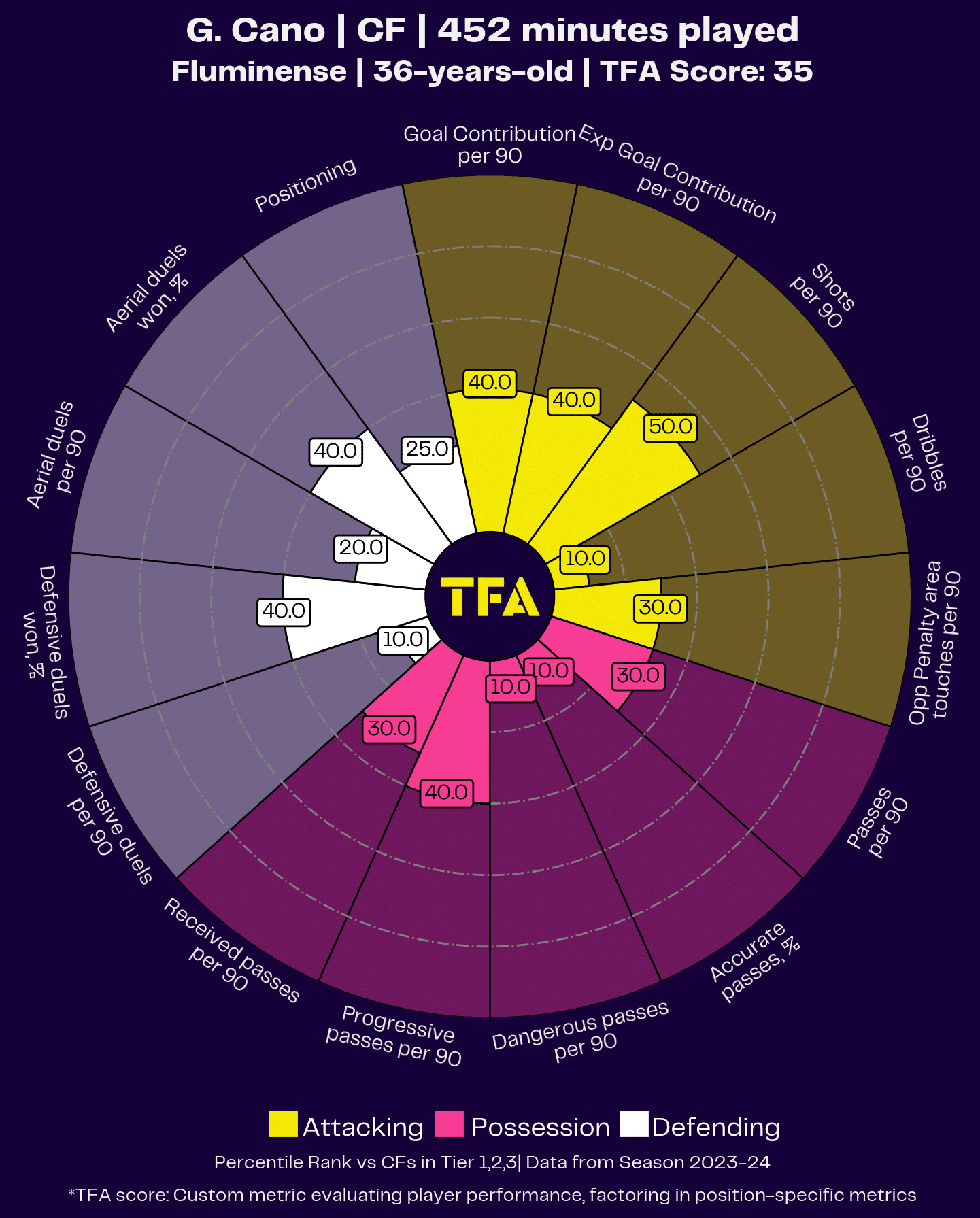
Below is the shot map for G.
Cano, further illustrates his performance.
The graphic reveals a significant gap between his output and shot selection, with only two non-penalty goals from 24 shots.
This is underwhelming for a starting striker, indicating inefficiency in converting opportunities into goals.
This disparity underscores the need for Cano to improve his finishing skills and shot accuracy better to fulfil his role as a leading forward for Fluminense.
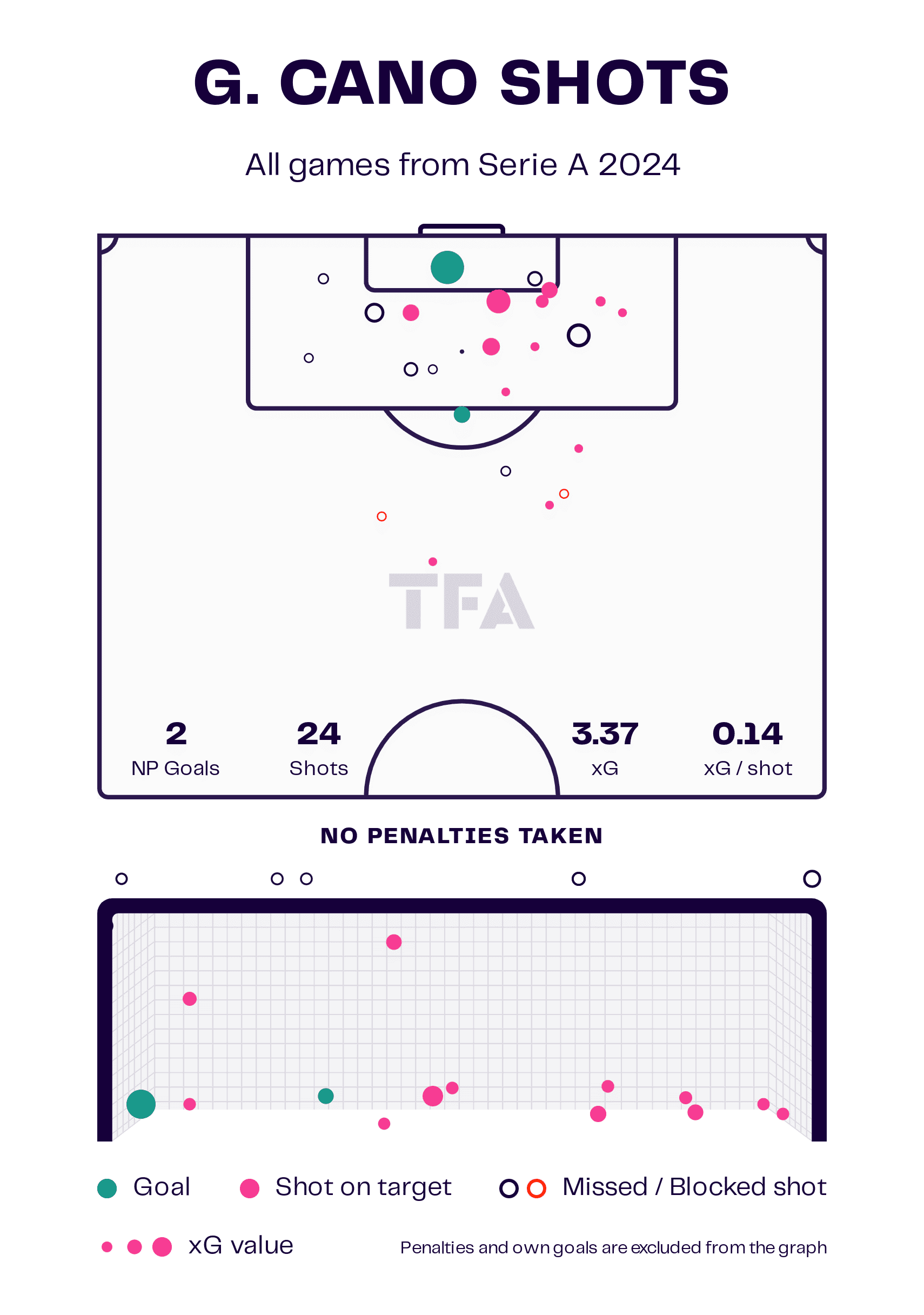
These are the key players Fluminense relies on to perform tactically on the field.
However, they no longer rank highly in percentiles and can’t move as they used to.
While these players can fulfil specific roles in a different tactical setup, they struggle in a system that requires rapid transitions from defence to attack and vice versa.
They are more suited to positional play and a different team vision.
Despite the challenges posed by an ageing squad, there are young hidden gems in the team who have the potential to excel and elevate the team’s performance to the next level.
Fluminense Key Young Players
Although the veteran players are currently hindering Fluminense’s performance, there is a core of strong young talent within the club.
While the defence lacks notable young players, the midfield and forward positions boast the serious talent that can potentially lead the club back to its glory days.
These young players possess the skills and potential needed to reinvigorate the team’s performance and contribute significantly to its future success.
Fluminense Midfielders – Martinelli and Andre
The radar chart for Matheus Martinelli, a 22-year-old right defensive midfielder for Fluminense, highlights his performance over 578 minutes played this season, focusing on his midfield capabilities.
Martinelli excels in passing, with an accurate passes percentage of 95.2% and passes per 90 ranking at 87.3%, showcasing his reliability in ball distribution.
His progressive passes per 90 (36.35%) and received passes per 90 (88.1%) indicate active involvement in advancing the play and maintaining possession.
Defensively, his metrics show solid engagement with defensive duels won at 55.3% and positioning at 46.2%, though his aerial duels won percentage (30%) suggests room for improvement.
Offensively, his goal contribution per 90 (44.6%) and expected goal contribution per 90 (61%) highlight his support role in attacking plays.
Martinelli’s performance underscores his strengths in ball distribution and defensive duties, making him a vital component of Fluminense’s midfield.
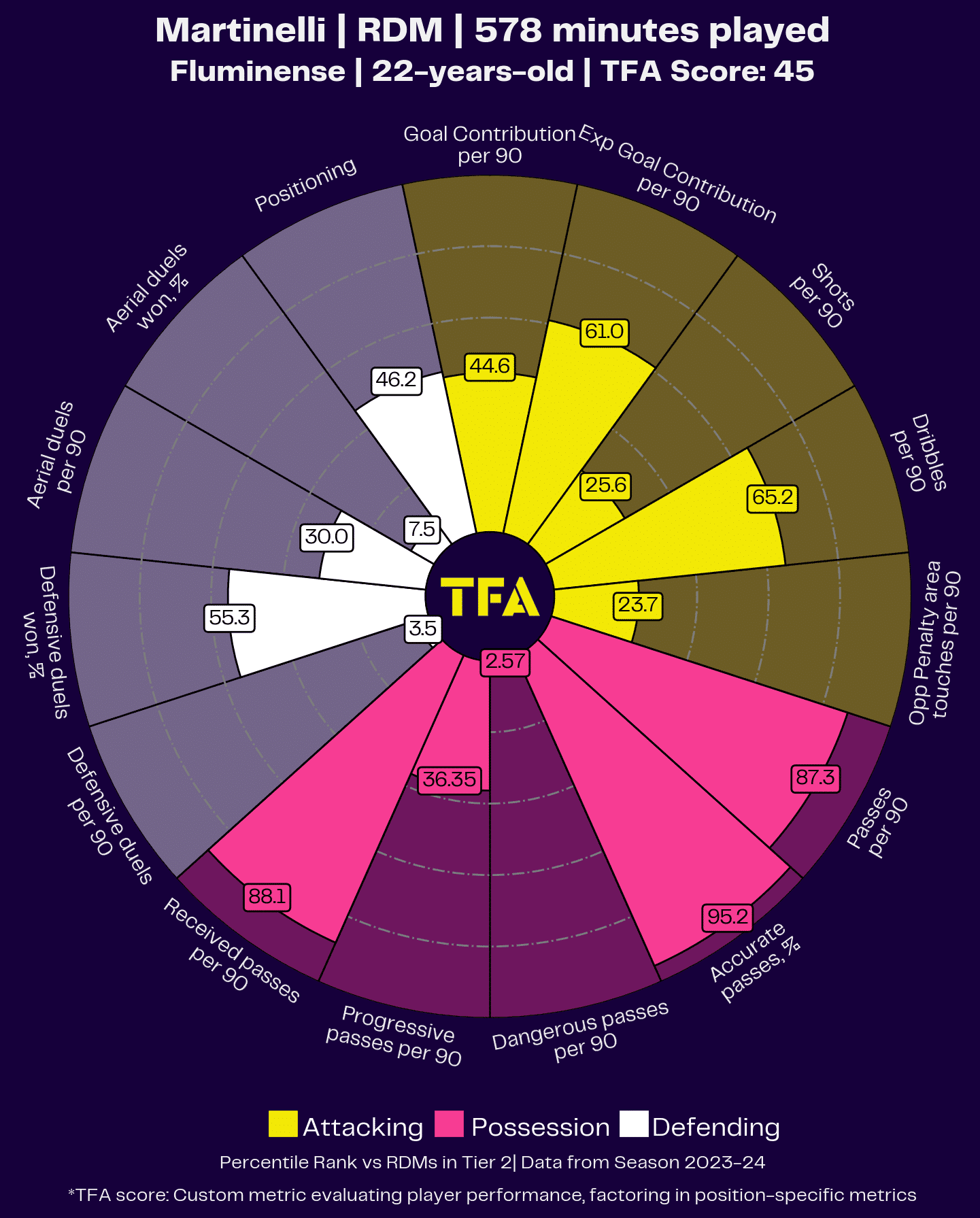
The radar chart for André, a 21-year-old left defensive midfielder for Fluminense, highlights his performance over 3323 minutes played this season, emphasizing his midfield traits.
André excels in passing, with an impressive 99.7% accuracy and 97.4 passes per 90, demonstrating his reliability and efficiency in ball distribution.
His received passes per 90 (97.9%) and progressive passes per 90 (76.4%) indicate his active role in maintaining possession and advancing the play.
Defensively, André shows strong engagement, winning 78% of his defensive duels, though his aerial duels won percentage (31.75%) and defensive duels per 90 (3.6%) suggest areas for improvement.
His attacking contributions, with a goal contribution per 90 of 27.2% and an expected goal contribution per 90 of 26.55%, reflect his potential to support offensive plays.
Overall, André’s performance underscores his strengths in ball retention, distribution, and defensive duties, making him a vital asset in Fluminense’s midfield.
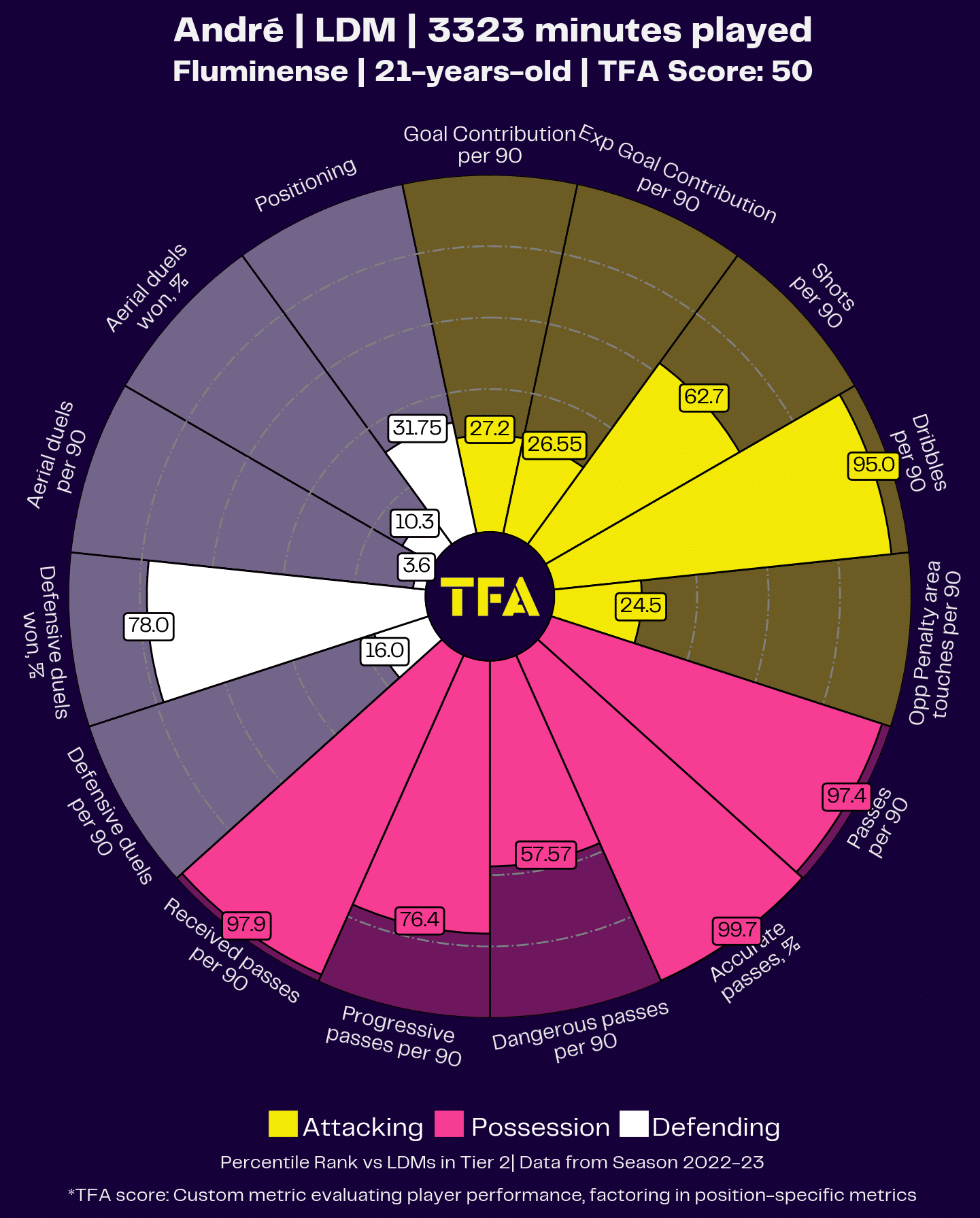
Fluminense Attackers – Marquinhos
Listed as a right-back (RB) but playing primarily as a right winger (RW) for Fluminense, Marquinhos’s radar chart highlights his attacking prowess over 620 minutes played this season.
Marquinhos shows significant offensive impact, with an impressive expected goal contribution per 90 of 96.3% and shots per 90 at 98.7%, demonstrating his active involvement in creating scoring opportunities.
His dribbles per 90 stand at 99.5%, showcasing his ability to take on defenders and drive the ball forward.
Additionally, his touches in the opponent’s penalty area per 90 (82.4%) reflect his consistent presence in dangerous attacking zones.
Marquinhos also excels in dangerous passes per 90 (64.5%) and accurate passes percentage (49.1%), indicating his effectiveness in delivering critical passes and maintaining possession under pressure.
Despite being listed as a defender, Marquinhos’s performance underscores his attacking capabilities, making him a key offensive asset for Fluminense.
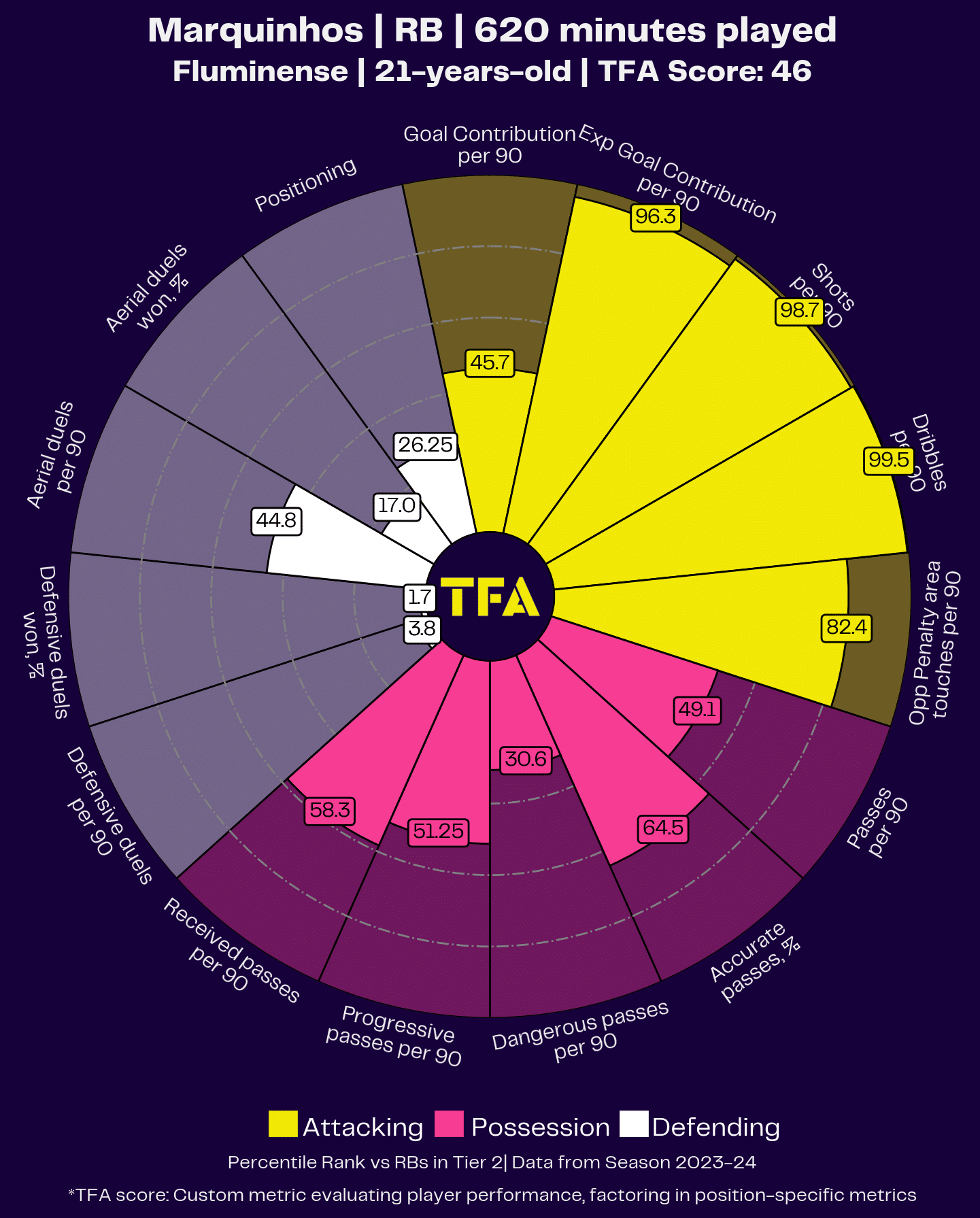
Conclusion
Fluminense FC’s season has been challenging, marked by their worst start since 2006 and a mere six points from twelve games. Despite a talented roster, the team’s struggles stem from managerial issues, injuries, and an ageing squad.
Fernando Diniz’s relationism philosophy is failing to deliver results, compounded by the inability to field a consistent starting lineup.
Veteran players like Fábio, Felipe Melo, and Marcelo have shown both strengths and vulnerabilities, while younger talents such as Martinelli, André, and Marquinhos display promising potential.
To reverse their fortunes, Fluminense must find a balance between experience and youth, make strategic adjustments, and improve defensive cohesion to leverage their strengths and address their weaknesses effectively.
They currently sit in 19th with 11 points in 17 matches with a -11 GD.
<hr><iframe src=”https://embeds.beehiiv.com/c4f610a9-06b3-402f-b90e-aecd169dd017″ data-test-id=”beehiiv-embed” width=”100%” height=”320″ frameborder=”0″ scrolling=”no” style=”border-radius: 4px; border: 2px solid #e5e7eb; margin: 0; background-color: transparent;”></iframe>





Comments